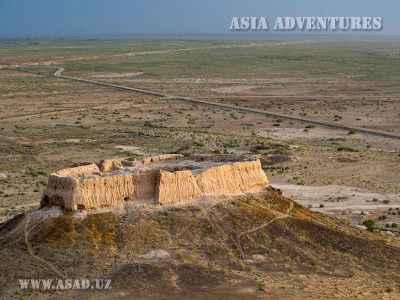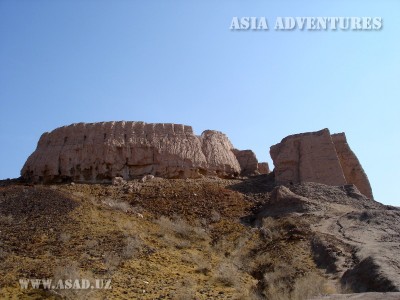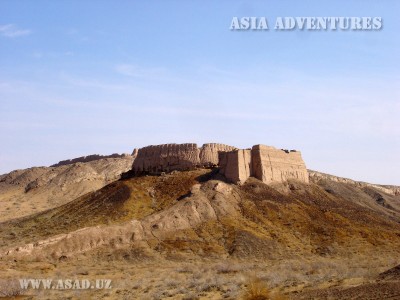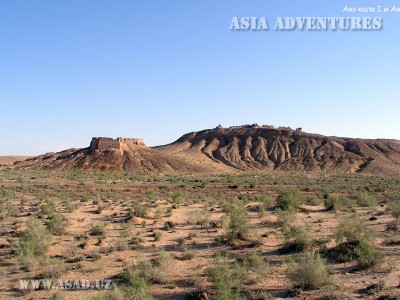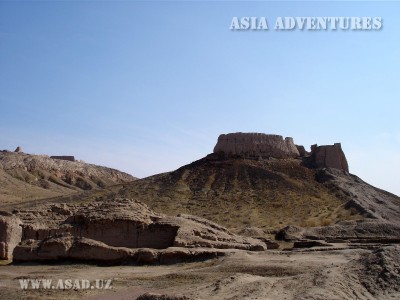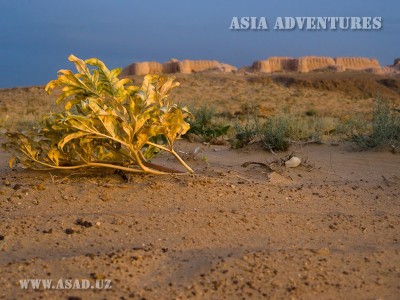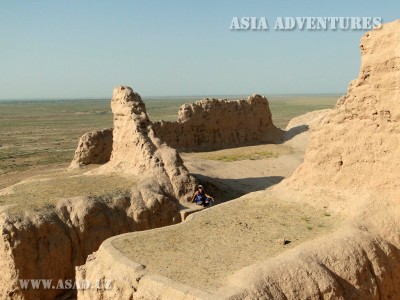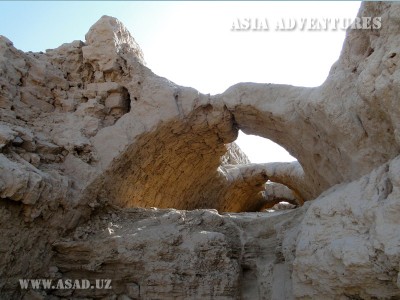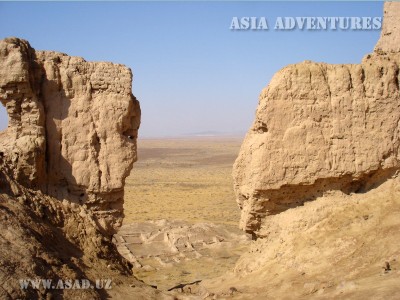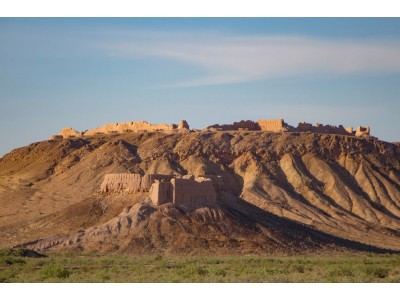
Ayaz-kala fortress (from Turkic – frosty, cold) is located in the north-west of Elikkalin district of the Republic of Karakalpakstan in 30 kilometers from Buston settlement and in 30 kilometers from Khiva and it is the most showy one among other fortresses of ancient Khoresm. In real, there is no one fortress, there is a complex of three fortresses, grouped around a hill in the eastern part of Sultan Uizdak ridge.. more...
The first fortress – Ayaz-kala I, located on the top of a high hill and rising above surrounded desert, it was one of the most reinforced fort outlying the desert Kyzylkum. Having taken up an important strategic position near Khoresm, it secured from raids of nomads and saks, living in the north of Syrdarya river delta. Ayaz-kala I embraces an area of 2,7 hectares and has a rectangular form. The walls are remained well about 10 meters height. The towers are visible until now in walls, two-high galleries for archers and gun slots, located in the same distance from each other. It is possible to come inside lower gallery from the level of ground surface not far from gates. Galleries secured and gave lightness of moving for many archers, who protected the fortress. Bow-shaped arches of lower galleries are survived till now, and tourists can walk inside those arches. It is considered that the building of this fortress started in V century BC, when a multilevel barrier was built. Later, in III century BC round towers were built additionally. But a semicircular form of towers, not typical for antique fortresses and on the contrary drawing together with forms of Afrigid fortifications, makes to date Ayaz-kala I from the middle or the end of Kushan time, to the period not early II and, probably, not later IV centuries AD. A complex labyrinth system of gates is typical for Khoresm border fortresses. The approach to gates lays parallel to the south-eastern wall, where invaded enemy became vulnerable to attack from above. Massive gates, protected by two rectangle towers, lead to a small rectangle area, surrounded by high walls from each side, where archers could shoot enemies from, if they break open the first gates. The turn orthogonally to the second gates, leading inside the fortress, destroyed the last enemies’ efforts, left after the breaking open the first gates. It is considered that the fortress continued using till about I century AD, even very much so it could be a refuge for local people till early medieval period.
There is a legend about this fortress, in ancient time Khoresm king ordered to build a fortress for protection of the northern borders of his state from raids of desert nomads. He told that person who could build such fortress, would get married with king’s beautiful daughter. The shepherd Ayaz, lived on the border of Khoresm, started to build a fortress, but then found out, that the king had broken his words and married off his daughter to another man. The shepherd stopped the building of fortress immediately, having heard about it, and it was left unfinished. It is interesting, that archeologists exploration showed, that it was really unfinished.
From the fortress there is a fascinating view of surrounding area, reaching to the West far, where you can see other chain links of border defensive buildings – fortresses Mali and Big Kyrk-kyz-kala, a quite big brine lake and, unfortunately, shoaling lake Ayazkala. There is a picturesque yurt camp Ayaz-kala at the foot of the fortress from the western side, where tourists can have rest, have lunch and ride Arabian camels.
The fortress Ayaz-kala II is a small nearly oval fortress, connected by a steep passage with open settlement on level ground to the West of the fortress. You can come inside through the gates from the south-western side, or climb on steep passage, or along the path, enveloping walls from the northern side.
The fortress dates to medieval period. Probably, it was founded during Afrigids epoch, about in the end of VII and the beginning of VIII century AD. Walls were built from clay press bricks and raised on the base from a mixture of clay and gravel, and upper part of walls was protected by castellation with gun slots. The inner construction is remained well, and inner cover is a roof of buildings. You can see the remains of the arched floor in those parts, where the erosion was. The float, coming down, once connected gates of the fortress with entrance to a big luxurious palace at the foot of the hill. That palace was described as the most beautiful building during medieval period in whole Central Asia. There were big halls with colons, an elegant bench, a ceremonial ground, a tablature and the temple of fire. The coins of Khoresmian kings of Afrigid dynasty, specifically coins of king Bravik, were found here. The palace was built in about IV century AD and then was destroyed by two fires followed each other. During the short time it was populated again and was used as housing in VI–VII centuries AD.
Ayaz-kala III is a reinforced building in the shape of parallelogram, located on the open valley lower fortresses Ayaz-kala I and Ayaz-kala II. This fortress is a settlement, which has a double wall, protected by rectangular towers into the perimeter, and gates of more complex construction in the middle part of the western wall. The fortress embraces an area of about 5 hectares. Outside walls were built during Kushan kingdom (I-II centuries AD). A lot of buildings were opened in the settlement, two huge estates, composed of more 40 rooms, are notable among them. The remains of many farmsteads with dwelling-houses, households, walls and vineyards were found around walls of the fortress.
There is a legend about this fortress, in ancient time Khoresm king ordered to build a fortress for protection of the northern borders of his state from raids of desert nomads. He told that person who could build such fortress, would get married with king’s beautiful daughter. The shepherd Ayaz, lived on the border of Khoresm, started to build a fortress, but then found out, that the king had broken his words and married off his daughter to another man. The shepherd stopped the building of fortress immediately, having heard about it, and it was left unfinished. It is interesting, that archeologists exploration showed, that it was really unfinished.
From the fortress there is a fascinating view of surrounding area, reaching to the West far, where you can see other chain links of border defensive buildings – fortresses Mali and Big Kyrk-kyz-kala, a quite big brine lake and, unfortunately, shoaling lake Ayazkala. There is a picturesque yurt camp Ayaz-kala at the foot of the fortress from the western side, where tourists can have rest, have lunch and ride Arabian camels.
The fortress Ayaz-kala II is a small nearly oval fortress, connected by a steep passage with open settlement on level ground to the West of the fortress. You can come inside through the gates from the south-western side, or climb on steep passage, or along the path, enveloping walls from the northern side.
The fortress dates to medieval period. Probably, it was founded during Afrigids epoch, about in the end of VII and the beginning of VIII century AD. Walls were built from clay press bricks and raised on the base from a mixture of clay and gravel, and upper part of walls was protected by castellation with gun slots. The inner construction is remained well, and inner cover is a roof of buildings. You can see the remains of the arched floor in those parts, where the erosion was. The float, coming down, once connected gates of the fortress with entrance to a big luxurious palace at the foot of the hill. That palace was described as the most beautiful building during medieval period in whole Central Asia. There were big halls with colons, an elegant bench, a ceremonial ground, a tablature and the temple of fire. The coins of Khoresmian kings of Afrigid dynasty, specifically coins of king Bravik, were found here. The palace was built in about IV century AD and then was destroyed by two fires followed each other. During the short time it was populated again and was used as housing in VI–VII centuries AD.
Ayaz-kala III is a reinforced building in the shape of parallelogram, located on the open valley lower fortresses Ayaz-kala I and Ayaz-kala II. This fortress is a settlement, which has a double wall, protected by rectangular towers into the perimeter, and gates of more complex construction in the middle part of the western wall. The fortress embraces an area of about 5 hectares. Outside walls were built during Kushan kingdom (I-II centuries AD). A lot of buildings were opened in the settlement, two huge estates, composed of more 40 rooms, are notable among them. The remains of many farmsteads with dwelling-houses, households, walls and vineyards were found around walls of the fortress.
Ayaz-kala fortress photos
 Posted by
Centralasia Adventures
Posted by
Centralasia Adventures
Touristic company “Asia adventures” - DMC operator in Central Asia.
Already 26 years, we organize any possible tours in Uzbekistan and other neighbor republics as Kazakhstan, Kyrgyzstan, Turkmenistan, Tajikistan, Kashgar (Western China) and the Caucasian region (Azerbaijan, Georgia, Armenia).
Tags:
fortress
uzbekistan

 Centralasia Adventures
+998712544100
Centralasia Adventures
+998712544100




